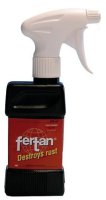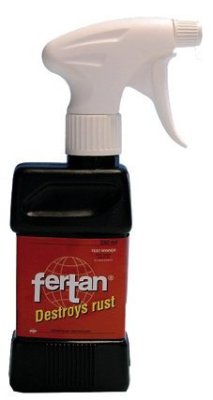FERTAN 250ML (ST)
Ref: SIN-22201
In stock: 15 pieces at external warehouse
Delivery period:
3 days
Product added

FERTAN 250ML (ST) is added to your shopping cart .
In stock at external warehouse
Reflection period 14 days
Free shipping from € 50.00 (BE)
Thanks
Thanks for your interest in FERTAN 250ML (ST).
We'll contact you soon.
FERTAN® is a rust converter that chemically attacks the original porous iron oxide layer. The result is a new (non-porous) iron compound. This protects the underlying metal from further rusting. FERTAN® can also be used without further finishing to protect steel for a longer period of time. This is an important property which is very useful for us during rust ornamentation work because we are not always able to paint clear parts directly.
It is also an important property for the protection of steel.
FERTAN® has three main ingredients:-;Pyrogallic tannin as a glycoside binder-;Metal additives, an impregnating agent and zinc-;Water
FERTAN® is a water-based product. For best results, it should be applied directly to the bare steel or to the rust. The effect is less effective if grease, paint or residues of previous anti-rust products are present.The surface should not be cleaned with e.g. gasoline, solvents, acetone or other similar substances. However, the surface may be cleaned with water-based cleaners.
It is important that there are no small invisible silicon particles left on the metal. These can come from e.g. previously applied soil protection agents, adhesive tape or soundproofing mats. It is also possible that blasting with a contaminated abrasive has introduced these substances into the pores of the metal!
FERTAN® can be applied directly to rusty surfaces. The product penetrates deeply into the rust layer and dissolves it. This process is accelerated by the water present in the FERTAN®. The now released surface is chemically converted by the Fertan into a new metal compound which protects the underlying layer. It is obviously important that this surface is not damaged. Should this nevertheless occur (scratches, abrasion, etc.) then the FERTAN® treatment must be repeated. The protective layer which is formed is highly resistant to chemical and atmospheric influences and is also water-insoluble.This metal compound, a polimeric-metal-organic layer, is a so-called iron tannin (a tannic acid compound). On as yet uncorroded surfaces:
It is quite possible to apply FERTAN® on not yet corroded surfaces and thus protect the metal from rust. The fact is that bare steel will immediately oxidize under the influence of oxygen in the air. This can be clearly seen under a microscope after only a few minutes. This process continues continuously and will therefore soon seriously affect the steel. By treating such a bare steel surface with FERTAN®, this corrosion is stopped even without applying coatings or the like. The thickness of the iron tannin layer formed is between 6 - 8 µ. On freshly ground or sanded parts, one should wait approximately 24 hours before applying FERTAN®. During that time, the oxide skin forms which is necessary for FERTAN® to do its job.
The treatment with FERTAN® creates a black colored layer on the metal. This layer should be rinsed off with ample water. What remains is bare steel again, but with a matt gray surface. This surface provides protection against further oxidation.
With rusted metal, the treatment with FERTAN® creates a black or blue violet layer. This depends on the percentage of carbon in the steel. With non-rusted metal, the FERTAN® treatment creates a matt metal surface.
FERTAN® can be applied by brush, roller or spray gun. The tools to be used for this purpose must be clean and free of grease. Therefore do not use brushes that have been cleaned with brush cleaner or spray guns that have recently been oiled. In such cases, the tool should first be thoroughly cleaned with a water-based cleaner.N.B. If you intend to apply FERTAN® with a brush or roller, use a new one or one previously used for FERTAN® . These should also only be cleaned with water. Other cleaning agents or brush cleaners can interfere with the proper functioning of the FERTAN®.
The application of Fertan in hollow spaces should preferably be done with air pressure spray gun. It is absolutely necessary to rinse with water the metal treated with FERTAN® before every post-treatment in order to remove the dissolved rust and the always present residual salts.The rinsing of hollow spaces is very important! In the hollow spaces (especially in the case of box girders), there is usually a lot of debris (loose rust, mud, leaves, brine residue, etc, etc) that should be removed before treatment. Rinsing out with plenty of water is the best solution here. Only then can FERTAN® be applied effectively. After the FERTAN® has been applied, it should be left to act for at least 24 hours, after which a further rinse with water is recommended. Then, for a very long protection, the cavity can be sprayed with a product such as HT-wachs.
In general it is sufficient to rinse the treated material thoroughly once. Use a sponge or wet cloth for this purpose. Rinsing with a high-pressure cleaner is also an option. If necessary, use rubber gloves because the black stuff that comes off is sometimes difficult to wash off the skin. Rinsing is particularly necessary if the material treated with FERTAN® is to undergo further treatments (painting, etc.).
-The treated surface must not be scratched or abraded. Do not use scouring pads for rinsing. Rinse with water only.
Cleaning the surfaces
You can remove loose rust with a wire brush (by hand or on the grinder). Parts previously treated with wax or other soil protective agents should be cleaned with a silicone solvent.
Important:Under no circumstances rinse with thinner, acetone, turpentine, gasoline etc.
Treatment of hollow spaces and body partsYou will notice that after rinsing with water, you still get black hands when you rub over surface of the metal. This is normal because due to the humidity the chemical reaction still continues. The resulting light powder layer binds to all types of materials and contains no harmful components. The surface is normally repaintable or weldable.
Hollow spaces:Hollow spaces (box girders, A- and B-pillars, etc) should after treatment with Fertan be treated with a water-dispersing hollow space wax (Fertan HT-Wachs). The best results are obtained with a pressure cup sprayer in combination with a 360° double round spray nozzle.
Important! The (wax) layer thickness must be at least 1.0 mm but not more than 2 mm. The wax must be able to "work", i.e. the cracks created in winter by freezing in summer are closed again by the heating of the wax. If the right layer thickness is applied, this process will provide excellent protection for the body inside for a long period of time. For best results it is recommended to repeat the wax treatment every 4 to 6 years.
Bodywork parts (exterior):After rinsing with water, the surfaces can be finished further with all commercially available agents. E.g. priming, filling, tinning, welding and/or painting.
FERTAN® is resistant to temperatures up to 420° C.
You have a new surface for the metal! The underside of a vehicle can be treated in various ways.After the FERTAN® treatment you can apply a primer coat. For example, you can use the unique 1K Epoxy primer FERPOX.
You can also apply a stone chip protection directly (Over-4-S) and after drying finish it with a color coating or apply a wax layer.
This is probably the best way to protect the underside for a long time. Stones, etc. are caught by the wax layer and the stone chip protection and do not penetrate to the metal. It is, however, advisable to regularly check the bottom for damage. The frequency of this of course depends on the intensity and nature of the use.
The use of FERTAN® in combination with other materialsFERTAN® can be used on steel parts that are connected to other materials such as wood, aluminum or stainless steel. FERTAN® will not damage these materials but can discolor them (darken them). If this is not desired, these parts should be carefully covered during the FERTAN® treatment. This can be done by taping or covering with an oil film or layer of grease. Caution: The parts to be treated must always be kept clean and free of grease.
 en
en
 Dutch
Dutch
 French
French


